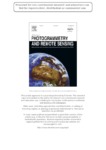Use este identificador para citar ou linkar para este item:
http://www.alice.cnptia.embrapa.br/alice/handle/doc/924819| Título: | A comparative analysis of ALOS PALSAR L-band and RADARSAT-2 C-band data for land-cover classification in a tropical moist region. |
| Autoria: | LI, G.  LU, D.   DUTRA, L.   BATISTELLA, M.   |
| Afiliação: | GUIYING LI, INDIANA UNIVERSITY; DENGSHENG LU, INDIANA UNIVERSITY; LUCIANO DUTRA, INPE; MATEUS BATISTELLA, CNPM. |
| Ano de publicação: | 2012 |
| Referência: | ISPRS Journal of Photogrammetry and Remote Sensing, v. 70, p. 26-38, 2012. |
| Páginas: | p. 26-38. |
| Conteúdo: | This paper explores the use of ALOS (Advanced Land Observing Satellite) PALSARL-band (Phased Array type L-band Synthetic Aperture Radar) and RADARSAT-2 C-band data for land-cover classification in a tropical moist region. Transformed divergence was used to identify potential textural images which were calculated with the gray-level co-occurrence matrix method. The standard deviation of selected textural images and correlation coefficients between them were then used to determine the best combination of texture images for land-cover classification. Classification results based on different scenarios with maximum likelihood classifier were compared. Based on the identified best scenarios, different classification algorithms ? maximum likelihood classifier, classification tree analysis, Fuzzy ARTMAP (a neural-network method), k-nearest neighbor, object-based classification, and support vector machine were compared for examining which algorithm was suitable for land-cover classification in the tropical moist region. This research indicates that the combination of radiometric images and their textures provided considerably better classification accuracies than individual datasets. The L-band data provided much better landcover classification than C-band data but neither L-band nor C-band was suitable for fine land-cover classification system, no matter which classification algorithm was used. L-band data provided reasonably good classification accuracies for coarse land-cover classification system such as forest, succession, agropasture, water, wetland, and urban with an overall classification accuracy of 72.2%, but C-band data provided only 54.7%. Compared to the maximum likelihood classifier, both classification tree analysis and Fuzzy ARTMAP provided better performances, object-based classification and support vector machine had similar performances, and k-nearest neighbor performed poorly. More research should address the use of multitemporal radar data and the integration of radar and optical sensor data for improving land-cover classification. |
| NAL Thesaurus: | texture |
| Palavras-chave: | ALOS PALSAR RADARSAT Land-cover classification Amazon |
| Tipo do material: | Artigo de periódico |
| Acesso: | openAccess |
| Aparece nas coleções: | Artigo em periódico indexado (CNPM)  |
Arquivos associados a este item:
| Arquivo | Descrição | Tamanho | Formato | |
|---|---|---|---|---|
| MateusISPRS.pdf | 2.25 MB | Adobe PDF |  Visualizar/Abrir |









